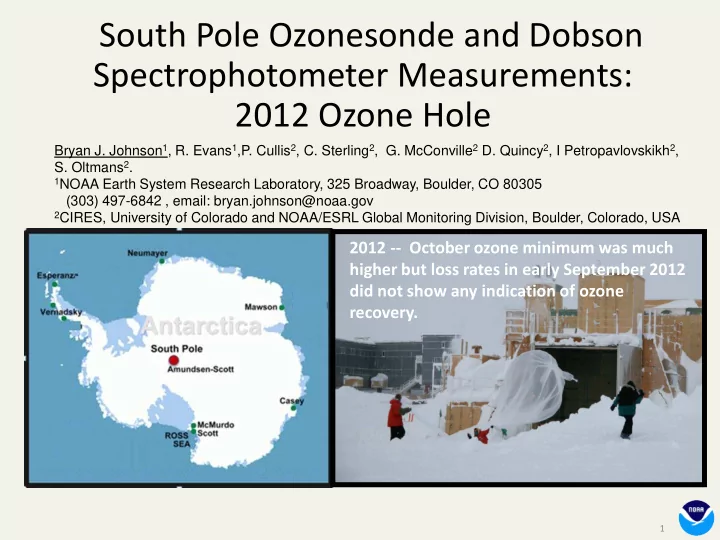

South Pole Ozonesonde and Dobson Spectrophotometer Measurements: 2012 Ozone Hole Bryan J. Johnson 1 , R. Evans 1 ,P. Cullis 2 , C. Sterling 2 , G. McConville 2 D. Quincy 2 , I Petropavlovskikh 2 , S. Oltmans 2 . 1 NOAA Earth System Research Laboratory, 325 Broadway, Boulder, CO 80305 (303) 497-6842 , email: bryan.johnson@noaa.gov 2 CIRES, University of Colorado and NOAA/ESRL Global Monitoring Division, Boulder, Colorado, USA 2012 -- October ozone minimum was much higher but loss rates in early September 2012 did not show any indication of ozone recovery. 1
NOAA GMD measures stratospheric ozone at South Pole from: 1. Ground-based Dobson spectrophotometer: 51 years 1962-2012 2. Balloon-borne ozonesondes: 27 years 1986-2012 UV Total Column ozone Balloon-Borne Ozonesonde 2
The Ground-based Dobson spectrophotometer and balloon-borne • ozonesondes - a good combination for tracking stratospheric ozone. • Dobson measures total column ozone as the view of the sun passes by the ARO Dobson room windows. Dobson Spectrophotometer at Ozonesonde launch at Atmospheric Research Balloon Inflation Facility (BIF) Observatory (ARO) 3
Summary of South Pole Sun Elevation Angle and Corresponding Ozone Measurements. Increased frequency of ozonesonde launches during ozone hole period. 4
NOAA/ESRL Global Monitoring Division Laboratory Review, April 3-5, 2013 5
The maximum and min range show large variability of total column ozone beginning after Sept 25. NOAA/ESRL Global Monitoring Division Laboratory Review, April 3-5, 2013 6
136 DU ranks as 23 rd lowest minimum ozone total in 27 year record NOAA/ESRL Global Monitoring Division Laboratory Review, April 3-5, 2013 7
2006 Ozonesonde Profiles 2012 8
2006 Ozonesonde Profiles 2012 4 2 0 8 6 4 2 0 8 6 4 2 High ozone 0 8 from outside 6 4 the vortex 2 0 9
SOUTH POLE OZONE 12-20 KM COLUMN Sondes flown at South Pole from 200 200 1967-1971 provide a good Average Range representation of full ozone hole 180 180 1986-2010 recovery (>50 yrs: Newman) COLUMN OZONE (Dobson Units) 160 160 140 140 ↓ Max & Min 120 120 100 100 1967-1971 80 80 1986-1990 The slower rate of ozone 60 60 depletion in the 12-20 km layer during 1986-1990 is a good 40 40 representation for first signs of 20 20 recovery. (~4-9 yrs: Hassler) 0 0 Jan Feb Mar Apr May Jun Jul Aug Sep Oct Nov Dec Linear Dobson Units/Day 10
SOUTH POLE OZONE 12-20 KM COLUMN 200 200 5 Year Averages Average Range 180 180 1986-2010 COLUMN OZONE (Dobson Units) 160 160 140 140 ↓ Max & Min 120 120 100 100 1967-1971 80 80 1986-1990 1991-1995 60 60 40 40 20 20 0 0 Jan Feb Mar Apr May Jun Jul Aug Sep Oct Nov Dec 11
SOUTH POLE OZONE 12-20 KM COLUMN 200 200 Average Range 180 180 1986-2010 COLUMN OZONE (Dobson Units) 160 160 140 140 ↓ Max & Min 120 120 100 100 1967-1971 80 80 1986-1990 1991-1995 60 60 1996-2000 40 40 20 20 0 0 Jan Feb Mar Apr May Jun Jul Aug Sep Oct Nov Dec 12
SOUTH POLE OZONE 12-20 KM COLUMN 200 200 Average Range 180 180 1986-2010 COLUMN OZONE (Dobson Units) 160 160 140 140 ↓ Max & Min 120 120 100 100 1967-1971 80 80 1986-1990 1991-1995 60 60 1996-2000 2001-2005 40 40 20 20 0 0 Jan Feb Mar Apr May Jun Jul Aug Sep Oct Nov Dec 13
SOUTH POLE OZONE 12-20 KM COLUMN 200 200 Average Range 180 180 1986-2010 COLUMN OZONE (Dobson Units) 160 160 140 140 ↓ Max & Min 120 120 100 100 1967-1971 80 80 1986-1990 1991-1995 60 60 1996-2000 2001-2005 2006-2010 40 40 20 20 0 0 Jan Feb Mar Apr May Jun Jul Aug Sep Oct Nov Dec 14
SOUTH POLE OZONE 12-20 KM COLUMN 200 200 Average Range 180 180 1986-2010 COLUMN OZONE (Dobson Units) 160 160 140 140 ↓ Max & Min 120 120 100 100 1967-1971 80 80 1986-1990 1991-1995 60 60 1996-2000 2001-2005 2006-2010 40 40 2011 20 20 0 0 Jan Feb Mar Apr May Jun Jul Aug Sep Oct Nov Dec 15
SOUTH POLE OZONE 12-20 KM COLUMN 200 200 Average Range 180 180 1986-2010 COLUMN OZONE (Dobson Units) 160 160 140 140 ↓ Max & Min 120 120 100 100 1967-1971 80 80 1986-1990 1991-1995 60 60 1996-2000 2001-2005 2006-2010 40 40 2011 2012 20 20 0 0 Jan Feb Mar Apr May Jun Jul Aug Sep Oct Nov Dec 16
“September loss rate dropping below about 3 DU/day at 12-20km can be used as another ozone recovery indicator”. David Hofmann et al. 1997 JGR 17
Summary GMD monitors stratospheric ozone at South Pole Station: -- Ground based Dobson Spectrophotometer observations ( 51 year record ). -- Balloon-borne ozonesonde profiles ( 27 year record ). • Total column minimum ranked at #23 in 27 year record for ozonesondes. • 12-20 km layer reduces influence of dynamics and shows the depletion rate remains in typical 3.2 to 3.8 DU per day range. • When do we expect first signs of recovery at South Pole? “Assuming a lineal relationship between ozone loss rate and Equivalent Effective Stratospheric Chlorine - a reduction of the ozone loss rate at South Pole station will be detectable in 2017-2021 period “ Hassler et al., (2011). 18
Recommend
More recommend